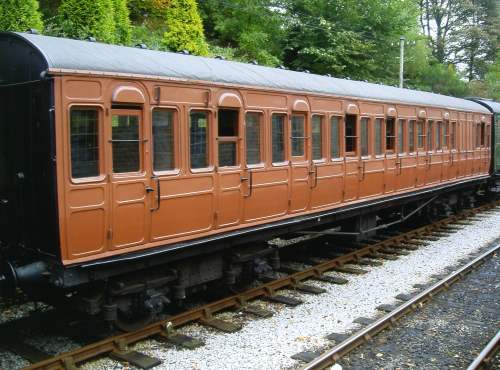

Metropolitan carriage No 427
Photo: Mark Astley
No. 427 seven-compartment Brake Third, body built 1910
on an underframe built in 1905
Length 54' 4" (16.560 m)
Width 9' 3" (2.820 m)
Weight 30 tons (30.5 tonnes)
Seats 84
Internal layout: Full width compartments without a side corridor
CURRENT STATUS: Available for filming use. Currently back at Ingrow.
This carriage, together with the other two "Dreadnought"
carriages represents the pinnacle of the
Metropolitan Railway's coaching stock. In the late 19th century, the
Metropolitan Railway was pushing northwest from London towards Aylesbury and
beyond. It eventually met up with the Manchester, Sheffield & Lincolnshire
Railway (or Great Central Railway, as it was by then), itself pushing south. The
beautiful coaches of the GCR shamed the Metropolitan Railway into producing
these "Dreadnought" coaches.
Nearly one hundred "Dreadnoughts" were built between 1910 and 1923. Special features which can be found on them are the unusually wide footboards and the curved tops to the doors, reducing the risk of damage if accidentally opened in tunnels.
427 was built by the Metropolitan Carriage, Wagon & Finance Company of Birmingham.
427 was originally built with gas lighting. This batch of carriages was also the first on the Metropolitan Railway to be fitted with a communication cord from new.
This type of carriage survived until electrification reached Amersham in September 1961, allowing replacement of this locomotive-hauled stock by electric multiple-unit trains. London Transport then stored six carriages at Upminster, Essex until needed in May 1963 for the Underground Centenary celebrations.
The three Metropolitan Railway carriages owned by the Trust were all initially purchased privately by Mr David Kitton from London Transport for the then-proposed Westerham Valley Railway preservation project. When this scheme failed, the carriages were loaned to the Worth Valley Railway in July 1965 and two of them – nos. 427 and 465 - formed part of this railway's Re-opening train in 1968. After extensive use in the earlier years of the railway the Vintage Carriages Trust purchased all three carriages from Mr Kitton in 1974.
The Metropolitan carriages are occasionally used on the Worth Valley Railway as a Vintage Train set. The Trust has embarked on a programme of cleaning, checking and making good where necessary the bogies and underframes of all three of the Metropolitan carriages.
Following painstaking research, this carriage was repainted during 1997 to another, much lighter, shade of London Transport brown known as Leaf Brown (BS381C-489) and the end of the Brake Compartment was painted Rail Red (BS381C-593). The Brake compartment itself is now resplendent in its authentic "Cerulean Blue". Ongoing "compartment by compartment" restoration continues for this carriage.
In March 2008 this carriage was repainted in the Blue and Primrose livery which it carried in 1968 when it was used on the Keighley and Worth Valley Railway's re-opening train. It was displayed alongside locomotive no. 30072 which was also repainted into its 1968 Worth Valley re-opening livery.
In January 2009 the carriage was repainted into the London Transport dark brown livery.
This carriage visited the National Railway Museum, York, in February 2006, February 2007, February 2008 and February 2009..
Although these are the only extant "Dreadnought" carriages, other Metropolitan Railway vehicles have survived. Some of these can be found on the Bluebell Railway.
Filming credits for this carriage:
The Railway Children Return; Testament of Youth (2014 version); Inside Out; The Forsyte Saga; Hound of the Baskervilles; The League of Gentlemen; The History of the London Underground (archive footage); Commercial for pensions; The Grand; The Unknown Soldier; Fairy Tale: a True Story; Holiday; The Secret Agent (1992 BBCTV version); Sherlock Holmes - the Bruce Partington Plans ; Sherlock Holmes - Wisteria Lodge; Without A Clue; Return of the Antelope; Sherlock Holmes - the Abbey Grange; A Woman of Substance; My Brother Jonathan; How We Used To Live; Sorrell and Son; BBCTV documentary about 1929 Rugby League Cup Final at Wembley; A Testament of Youth; Yanks; Raffles: The First Step; The Seven Per Cent Solution;
Filming credits before purchase by Vintage Carriages Trust:
Commercial for Schweppes; The Railway Children (1970 EMI version); The Virgin and the Gypsy; The Private Life of Sherlock Holmes; The Railway Children (1968 BBCTV version); Commercial for Symbol biscuits
Carriage Survey entry for this carriage